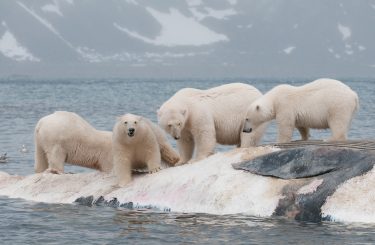
Polar bears likely survived past warm periods in the Arctic, when sea ice cover was low, by scavenging on the carcasses of stranded large whales. This food source sustained the bears when they were largely restricted to land, unable to roam the ice in search of seals to hunt.
A new study led by the University of Washington found that although dead whales are still valuable sources of fat and protein for some polar bears, this resource will likely not be enough to sustain most bear populations in the future when the Arctic becomes ice-free in summers, which is likely to occur by 2040 due to climate change. The results were published online Oct. 9 in the journal Frontiers in Ecology and the Environment.
“If the rate of sea ice loss and warming continues unmitigated, what is going to happen to polar bear habitat will exceed anything documented over the last million years. The extremely rapid pace of this change makes it almost impossible for us to use history to predict the future,” said lead author Kristin Laidre, a marine biologist at the UW’s Polar Science Center and associate professor in the School of Aquatic and Fishery Sciences.
Read more at UW Today »
